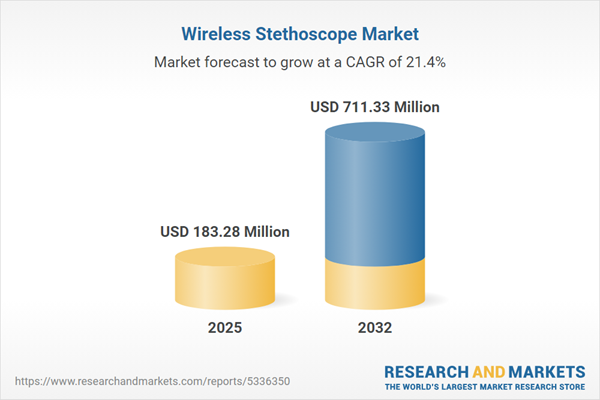Speak directly to the analyst to clarify any post sales queries you may have.
The wireless stethoscope market is advancing rapidly, reshaping how clinical diagnostics are delivered and paving the way for streamlined remote care. Senior decision-makers are steering high-value investments into connected health devices to strengthen telemedicine capabilities and data-driven clinical workflows.
Market Snapshot: Wireless Stethoscope Market Growth and Outlook
The wireless stethoscope market grew from USD 151.22 million in 2024 to USD 183.28 million in 2025. It is expected to continue expanding at a CAGR of 21.35%, ultimately reaching USD 711.33 million by 2032. Demand is fueled by increased telehealth adoption, healthcare digitalization, and the need for advanced diagnostic accuracy across diverse healthcare settings.
Scope & Segmentation
- Technology: Bluetooth, Wi-Fi (2.4 GHz and 5 GHz bands)
- End User: Clinics, Hospitals
- Application: Cardiology (adult and pediatric), General Medicine (internal medicine, primary care), Pediatrics
- Distribution Channel: Direct sales (government tenders, hospital contracts), Distributors (medical device distributors, third-party resellers), Online (company websites, e-commerce platforms)
- Region: Americas (United States, Canada, Mexico, Brazil, Argentina, Chile, Colombia, Peru), Europe (United Kingdom, Germany, France, Russia, Italy, Spain, Netherlands, Sweden, Poland, Switzerland), Middle East (United Arab Emirates, Saudi Arabia, Qatar, Turkey, Israel), Africa (South Africa, Nigeria, Egypt, Kenya), Asia-Pacific (China, India, Japan, Australia, South Korea, Indonesia, Thailand, Malaysia, Singapore, Taiwan)
- Key Companies Analyzed: 3M Company, Hill-Rom Holdings, Inc., Eko Health, Inc., Thinklabs Medical, Inc., Cardionics, Inc., Zargis Medical Corp., Dr Trust India Private Limited, MDF Instruments, LLC
Key Takeaways for Decision-Makers
- Wireless stethoscope technology enhances real-time data accessibility and supports clinical workflows well beyond traditional auscultation tools.
- Digital sound-processing and cloud connectivity allow for more consistent diagnostic outcomes and facilitate integration with electronic health records.
- Strategic partnerships between manufacturers and health IT providers are accelerating market adoption by easing clinical integration and supporting telemedicine growth.
- Differentiation in device performance and support services is crucial, as clinical priorities vary significantly between clinics and larger hospitals.
- Market leaders are navigating shifting compliance demands by investing in cybersecurity, ensuring resilience through encrypted devices and robust user authentication.
- Regional nuances—such as telehealth maturity and regulatory harmonization—directly influence adoption rates, making localized go-to-market approaches essential.
Tariff Impact: Shifting Supply Chains and Pricing Strategies
The introduction of new United States tariffs on medical device components in 2025 has prompted manufacturers to reevaluate supply chain sourcing and unit cost management. Adjustments in procurement strategies have led to increased nearshoring and efforts to optimize agreements in lower-tariff regions. Despite incremental cost pressures, manufacturers continue to meet stringent reliability and safety standards, maintaining competitive differentiation. Device feature sets are increasingly prioritized for core functionality as innovation pacing is temporarily recalibrated under new cost structures.
Methodology & Data Sources
Market analysis relies on primary interviews with healthcare professionals, procurement specialists, and industry executives for deep insight into user priorities and market challenges. The research is augmented with comprehensive secondary data from regulatory documents, scientific literature, and industry reports. Triangulation and statistical analysis ensure consistency, data integrity, and robust trend validation.
Why This Report Matters
- Enables informed strategic planning by equipping industry leaders with actionable intelligence on emerging wireless auscultation technologies.
- Supports risk mitigation and market entry tactics through a clear understanding of tariff implications and compliance requirements.
- Provides actionable segmentation to support targeted investment, regional expansion, and product positioning initiatives.
Conclusion
The wireless stethoscope market is experiencing active transformation as digital health advances and regulatory environments evolve. Senior decision-makers can leverage these insights to innovate, adapt supply strategies, and capitalize on future growth opportunities in connected healthcare.
Additional Product Information:
- Purchase of this report includes 1 year online access with quarterly updates.
- This report can be updated on request. Please contact our Customer Experience team using the Ask a Question widget on our website.
Table of Contents
3. Executive Summary
4. Market Overview
7. Cumulative Impact of Artificial Intelligence 2025
Companies Mentioned
The companies profiled in this Wireless Stethoscope market report include:- 3M Company
- Hill-Rom Holdings, Inc.
- Eko Health, Inc.
- Thinklabs Medical, Inc.
- Cardionics, Inc.
- Zargis Medical Corp.
- Dr Trust India Private Limited
- MDF Instruments, LLC
Table Information
| Report Attribute | Details |
|---|---|
| No. of Pages | 186 |
| Published | November 2025 |
| Forecast Period | 2025 - 2032 |
| Estimated Market Value ( USD | $ 183.28 Million |
| Forecasted Market Value ( USD | $ 711.33 Million |
| Compound Annual Growth Rate | 21.3% |
| Regions Covered | Global |
| No. of Companies Mentioned | 9 |









